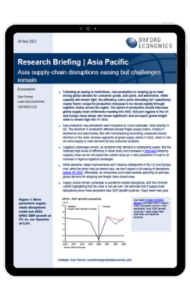Asia supply-chain disruptions easing but challenges remain

Following an easing in restrictions, Asia production is ramping up to meet strong global demand for consumer goods, auto parts, and electronics. While capacity will remain tight, the efficiency Asia’s ports (including 24/7 operations) means there’s scope for production increases to be moved rapidly through logistics chains across the region. The upturn in production should help ease global supply-chain bottlenecks heading into 2022. But port logjams in the US and Europe mean delays will remain significant, and we expect global freight rates to remain high into H1 2022.
What you will learn from this report:
- Asia production has periodically been impacted by Covid outbreaks, most recently in Q3. The downturn in production affected already fragile supply chains, notably in electronics and automobiles. But with manufacturing recovering, pressures should diminish on the more complex segments of global supply chains in 2022, which in turn will allow supply to meet demand for key consumer products.
- Logistical challenges remain, as container ship demand is outstripping supply. But the relatively high levels of efficiency in Asian ports and increases in intra-Asia shipping capacity mean we do not expect the current ramp-up in Asia production to lead to an increase in regional logistical blockages.
- While welcome, these improvements won’t resolve chokepoints in the US and Europe. And, while the worst may be behind Asia, we don’t expect a full easing of disruptions before H2 2022. Afterwards, as consumers pivot back towards spending on services, global demand for shipping and freight rates should ease.
- Supply chains remain vulnerable to pandemic-related disruptions, with the Omicron variant highlighting that the crisis is not yet over. We estimate that if supply-chain disruptions prove more persistent Asia GDP growth could be 1.6ppt lower next year..
Tags:
Related Services

Post
APAC Key Themes 2026: Paybacks, policy offsets and trade
We believe APAC will remain the strongest global performer in 2026. However, the growth trajectory will likely be more uneven than in past cycles.
Find Out More
Post
Japan’s fiscal policy will remain loose, which increases risks to debt sustainabilit
We've changed our fiscal outlook for Japan in our December forecast round. We now expect the new government to set a primary deficit close to that of 2024, at 2%-3% of GDP for 2025-2027, instead of restoring a balanced budget by taking advantage of strong tax revenue. We assume higher bond yields will force the government to take measures to reduce the deficit from 2028.
Find Out More